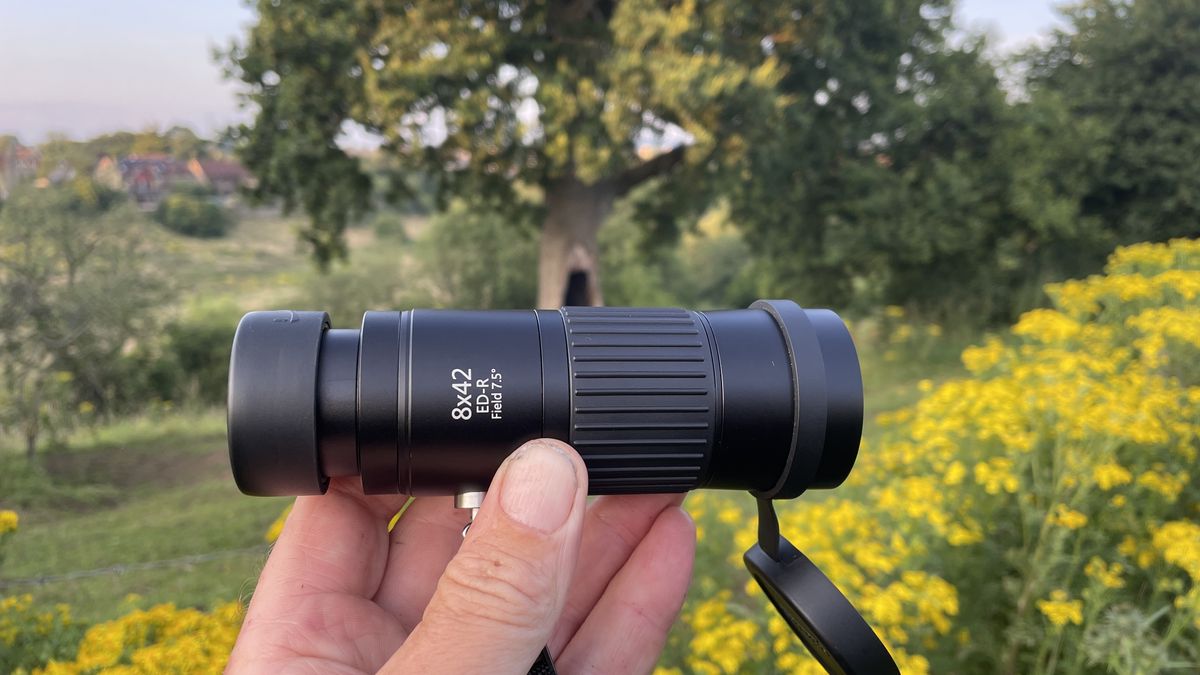:focal(742x537:743x538)/https://tf-cmsv2-smithsonianmag-media.s3.amazonaws.com/filer_public/a7/55/a755cb1c-24bd-4bb1-9439-378020c57370/dec2024_k14_prologue-1.jpg)
Two ivory-billed woodpeckers in one of the historic photographs that Arthur Allen captured in the field in 1935.
Division of Rare and Manuscript Collections, Cornell University Library
Arthur Allen carefully packed his camera and luggage at his home in Ithaca, New York. He would soon head south to the backwood swamps of Osceola County, Florida, to search for a ghost bird: the ivory-billed woodpecker. Most scientists considered it extinct; Allen was desperate to prove them wrong.
The year was 1924, and Allen was an energetic ornithology professor at Cornell University, about to take a sabbatical. A stocky, outgoing man with a bushy mustache, he’d always been popular with his students, who called him Doc Allen and liked how he never talked down to them. He’d been born and raised in working-class Buffalo, New York, moving to Ithaca in 1904 to study at Cornell and never left.
Allen was not the first to be enthralled by this charismatic bird, the largest woodpecker in the U.S., with stunning black-and-white plumage, gleaming white bill and yellow eyes. In the 18th century, the English artist and naturalist Mark Catesby described the bird and painted it for the first volume of his Natural History of Carolina, Florida and the Bahama Islands, published in 1731. The bird later caught the attention of several early 19th-century naturalists, including artists Alexander Wilson and John James Audubon, who included paintings of the species in their books. For artistic accuracy, they collected a few specimens—which was not a problem at that point. But that soon changed, as people cut down vast tracts of forest to make way for farmland, destroying vital habitats. They also killed many birds for commercial gain, driving some species to extinction—most notably the passenger pigeon, which was shot by the millions as food for people and livestock.
The redoubtable ivory-billed woodpecker perched on a willow oak, painted by the English naturalist Mark Catesby in the 1720s. The Royal Collection/https://tf-cmsv2-smithsonianmag-media.s3.amazonaws.com/filer_public/75/26/7526f99b-97a9-4e95-a759-6199b9aa4db6/dec2024_k11_prologue.jpg)
Allen was obsessive about studying birds—especially species that were vanishing. At this point, the great auk, passenger pigeon and Carolina parakeet were already extinct, and most thought the ivory-billed woodpecker was also gone. Allen was determined to spend months if necessary scouring Florida in search of this bird, to study the species in depth and take photographs. The trip would herald a new era in ornithology—one where scientists stopped killing rare birds and started trying to keep them alive.
Before 1796, when French scientist Georges Cuvier first proposed the concept of extinction, people didn’t know a species could be lost forever. The idea that any of God’s creatures could just vanish from the earth was simply unthinkable. In the previous decade, Thomas Jefferson had written: “Such is the economy of nature that no instance can be produced of her having permitted any one race of her animals to become extinct.” And yet in the Victorian era, when people did become aware that species could be lost, it only heightened their interest in shooting them to add to collections. The Victorian age was the heyday of specimen collecting—especially birds and their eggs—and the species closest to extinction were the ones most prized. “Now is the time to collect,” wrote W.T. Hornaday, then the Smithsonian’s chief taxidermist, in an 1891 book. “The time will come when the majority of the vertebrate species now inhabiting the earth … will be either totally exterminated or exist only under protection.”
Allen, known to his Cornell students as calm and easygoing, watches an ivory-bill nest in the field, April 1935. Division of Rare and Manuscript Collections, Cornell University Library (2)/https://tf-cmsv2-smithsonianmag-media.s3.amazonaws.com/filer_public/60/04/6004ab97-ce3d-4be8-8a74-957d29d9d229/dec2024_k02_prologue.jpg)
Prominent figures in ornithology were involved in the slaughter. William Brewster—co-founder and an early president of the American Ornithologists’ Union (AOU), now the American Ornithological Society—owned more than 40,000 specimens and later became curator of Harvard’s Museum of Comparative Zoology. He shot many birds himself and bought rare bird carcasses from other enthusiasts, including his friend Arthur T. Wayne. After one trip in 1892, Wayne wrote Brewster that he had collected 43 Bachman’s warblers (a bird now extinct) and 13 “fine ivory-billed woodpeckers.” Wayne later placed an advertisement on the back cover of the AOU’s journal, The Auk, offering four pairs of ivory-bills for sale. It appeared below an ad for repeating rifles.
Scientists certainly knew what was happening with the ivory-bill. “The probabilities are that [the ivory-billed woodpecker] will soon be extinct,” wrote naturalist Charles Abbott in 1894. “It is too handsome not to tempt every collector, taxidermist and millinery establishment in the country, and he who protests will be laughed at for his trouble.”
Besides the birds being killed by collectors, millions of herons, egrets and other birds were being slaughtered for the fashion industry to provide adornments for women’s hats and other garments. Yet some began to blanch at this cruel ostentation. A group of wealthy society women in Boston began arranging boycotts of feathered garments and eventually formed the Massachusetts Audubon Society, dedicated to bird conservation. Soon more Audubon Societies were formed in other cities and states. But these conservationists were not always taken seriously by professional ornithologists, who often viewed them as parochial animal lovers and laughed at their efforts. When AOU president Charles B. Cory was invited to attend an Audubon Society meeting in 1902, he replied: “I do not protect birds. I kill them.”
Arthur Allen was different. He cared deeply about living birds and dedicated himself to studying them. No one had ever done an in-depth study of an ivory-billed woodpecker, and though he knew the bird might already be extinct, he felt he had to try.
Florida had been a stronghold for ivory-bills in past decades and was where most museum specimens of the bird—which already numbered in the hundreds—had come from, so that’s where he set his sights. Perhaps he could find some forgotten nook of the state where a few of them still managed to hang on. The problem was where to look. Florida is huge, and he had a limited amount of time.
Allen advertised that he was willing to pay for information that could point him to a living ivory-bill. He heard from several people and spent nearly a month checking their claims, but the birds all turned out to be common pileated woodpeckers. Then a rancher named Morgan Tindall got in touch, claiming he’d seen an ivory-bill less than 30 miles from where Arthur Allen and his wife, fellow ornithologist Elsa, were staying. Tindall’s description of the bird was spot-on, so they arranged to spend a few days camping with him near where he’d seen it.
Tindall was sitting in his battered Ford Model T when the Allens arrived at their meeting place. He was a tall, wiry man in his 60s with a droopy gray walrus mustache and a flat-brimmed Stetson. The Allens quizzed him about his sighting and listened closely as he talked about all the ivory-bills he’d seen over the years while working cattle.
It was a wild ride as they tore across the trackless pine barrens with Tindall in the lead. He finally stopped near the cypress swamp where he’d seen an ivory-bill, and they set up camp.
The Allens spent the rest of the day tramping up and down the swamp, but it wasn’t until dawn the next morning that they heard the telltale call of an ivory-bill. Later, as the fog began to lift, they finally spotted the bird perched atop a dead pine. An instant later, it was joined by its mate.
The Allens spent another day with the ivory-bills and took several photographs, but it soon became clear the birds were still courting and hadn’t yet laid eggs. If the Allens bothered them too much at this early stage, they might discourage them from nesting. As far as Arthur Allen knew, this might be the last breeding pair of ivory-bills in the world, so he decided to leave them alone for a couple of weeks to be safe.
Allen immediately wrote an exuberant dispatch for Bird-Lore (the precursor to Audubon magazine): “I have just enjoyed one of the greatest experiences of my life, for I have found that which they said could not be found—the ivory-billed woodpecker.”
His joy was short lived. When he returned to the nest site a couple of weeks later, the birds were gone, and the mud at the edge of the swamp was full of fresh boot prints. He later found out that a couple of local taxidermists had heard about the ivory-bill’s rediscovery and shot the birds.
The loss of those ivory-bills was devastating to Allen. He sent letters to many people, including Audubon president T. Gilbert Pearson. “I wish we could do something to get complete protection for the ivory-bills from ambitious taxidermists and collectors,” he wrote. Allen had just taken over as chairman of the AOU’s Committee on Bird Protection—which had been completely ineffectual before then. As Willard Van Name of the American Museum of Natural History wrote in a letter to Allen, “The Committee on Bird Protection which preceded yours was appointed with the express purpose of doing nothing, and performed that function with admirable efficiency for many years, thereby materially assisting many of our finest birds on their way to extinction.”
“While I am chairman,” Allen replied, “I shall make an effort each year to have such matters brought before the convention.” At the next annual meeting of the AOU, Allen got three conservation resolutions passed—including one demanding the complete protection of any species on the verge of extinction. But his greatest achievement was to establish a different way of doing bird research, focused on observing living birds, especially those in trouble.
A few years later, Allen located another nesting ivory-bill pair in an old-growth forest in Louisiana and finally had a chance to do an in-depth study. He sat watching the nest for days, taking notes on everything the birds did. He also took spectacular still photographs and motion pictures, while his associate, Peter Paul Kellogg, made the first sound recordings of the species. (In 2021 the U.S. Fish and Wildlife Service moved to declare the bird extinct, but some ornithologists believe the bird is still out there, so the government held off—for now.)
The Allens at Cornell, holding two volumes of a rare edition of American Ornithology by Alexander Wilson, whom Elsa called “the father of American ornithology.” Division of Rare and Manuscript Collections, Cornell University Library/https://tf-cmsv2-smithsonianmag-media.s3.amazonaws.com/filer_public/7f/91/7f9141cd-8a6e-4f6b-8a01-9205cd9d65f8/dec2024_k03_prologue.jpg)
Allen’s greatest accomplishment was the fundamental paradigm shift he helped effect in the field of ornithology. Through a lengthy career, he popularized bird study, eventually teaching more than 10,000 Cornell undergraduates and directing the studies of some of the most renowned ornithologists of the 20th century. He also founded the Cornell Lab of Ornithology, a major force in bird conservation.
When pesticides drove the North American peregrine falcon to near-extinction in the 1960s, Tom Cade, a Cornell professor and director of raptor research at the Lab of Ornithology, set up a massive captive-breeding project, producing several thousand young falcons and releasing them into the wild. The peregrine falcon bounced back and was removed from the endangered species list in 1999.
Bird conservation has thrived since then, with successes such as the California condor and the whooping crane. And now we have the Search for Lost Birds project—a worldwide citizen-science venture to help people search for 144 bird species that have not been seen in a decade or more. Today’s scientists will do their absolute best to save them from extinction. Arthur Allen deserves a great deal of credit for bringing about this profound change in attitude.









Leave a Comment